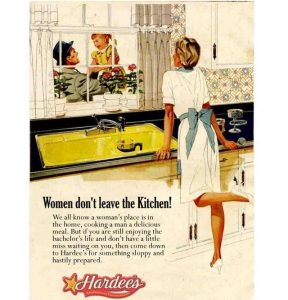Original Advertisement:

Source of the advertisement: http://neatdesigns.net/35-extremely-sexist-ads-that-you-should-see/
As one can tell from the logo, this image is an advertisement of an American fast-food restaurant called Hardee’s back in the 1940’s. There seems to be many chain restaurants of Hardee’s in America and other countries. There seems to be as many as 3000 chain restaurants in America and also quite a few chain restaurants in other locations. One could tell that Hardee’s is probably a quite successful and well-known chain restaurant in America and that the viewers of this advertisement was likely to be a vast number of customers. Thus, it makes it even more difficult to believe that the advertisement of this popular fast-food restaurant would contain such sexist contents and that the discriminatory message is conveyed in a very direct way. The sexist content of this advertisement is obvious from the title which is “women don’t leave the kitchen” and the smaller texts below it. The title of this advertisement suggests the common role that women played or were thought to be supposed to play in the society and in families in that particular time. Examples of the main responsibilities or duties of women were likely to be doing the chores, cooking for their family members, and taking care of the children. In addition to be tiltle of this advertisement, the smallers texts below it further suggests the way that women were viewed as in the society at that time. Phrases such as “a little miss” were used in the advertisement to refer to the wife and this detail suggests the social position of women in the family. It is not unreasonable to analyze that women were viewed as a maid to a certain extent who were thought to be required to take care of their husbands.
My jammed version of this advertisement:

This image my edited version of the 1940’s Hardee’s advertisement. As one can see, I have changed certain words or phrases that express sexist ideas towards women to contents that suggest gender equality to a certain extent. For example, I have changed the word “don’t” to “can” to convey the idea that women deserve the right to decide on their own whether they want to stay in the kitchen or not. I think the idea that women should work in the kitchen most of the time and that cooking is one of their main duties is ridiculous and that it is a form of direct discrimination against women. By limiting women’s choices on their lifestyles and deciding that they should occupy the private domain of the society primarily is an obvious social phenomenon of sexism. The simple modification of the word “don’t” to “can” is meant to suggest that women should have the right to leave the kitchen and engage in social activities outside their homes such as working in the company or pursue their own career goals. Furthermore, I have also changed the phrase “cooking a man a delicious meal” to “if she chooses to”. Similar to the title, the purpose of this amendment is to express the idea that women are not necessarily required to cook for their husbands if they do not want to. Women should be the ones to decide what kind of lifestyles they want to adopt. Lastly, I changed the phrase “…don’t have a little miss waiting on you…” to “want to try some home cooking”. This change is aimed to direct the attention of the viewers to the main purpose of this advertisement and also try to promote the restaurant to the public.
Hardees Menu Hardee’s has carried communities collected with quality & delicious food. There are more than 1,800 restaurants across the U.S. Moreover, the restaurant has sub-store locations in 14 countries across the world. They are loyal to the best tasting food to better serve the customers.
Hey, I just wanted to let you know that this image was actually from a 1961 Kohler advertisement. I don’t know where the caption and blurb came from, but the Hardee’s logo wasn’t used until 2006. That isn’t to discredit your work but it goes to show how shockingly recent the sexism was injected into this image. Your edit has a nice and empowering message!